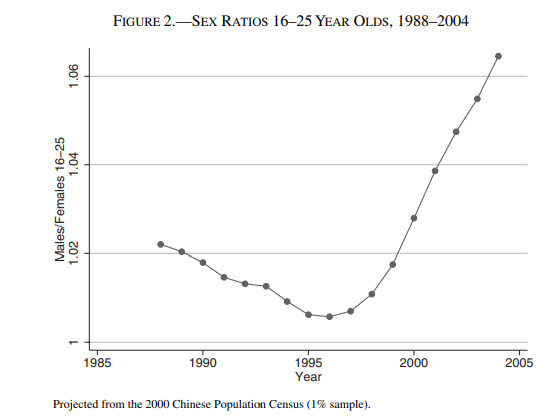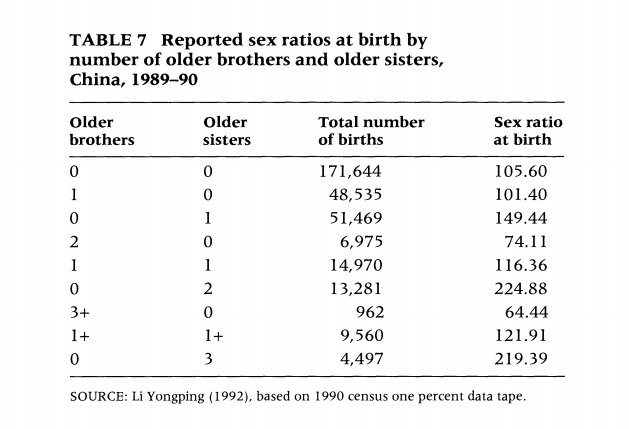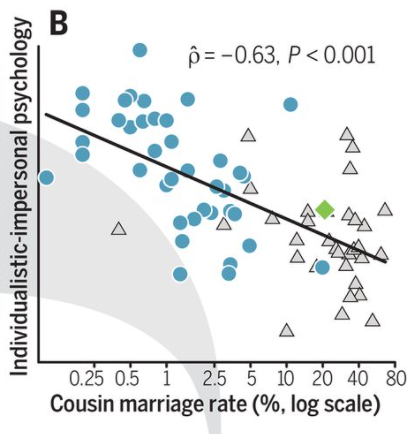
I am just an anonymous freedom fighter!
Planned Parenthood, Singles, and Clan Disintegration
Inspired by the article of Matt City@ Ghost Hit the Wall , I began to think about the relationship between family planning and the huge gender imbalance in contemporary China. Of course, we all agree that culturally, the patriarchal tradition comes from the patriarchal clan system and cultural psychology, and is not seen in Western civilization. This culture is not limited to regions such as China and South Korea, which are deeply influenced by Confucian culture. This boy preference culture is also prevalent in India, Bangladesh and other regions of the South Asian subcontinent. According to the summary of Jeseph Henrich (2019), in areas not affected by the Eastern and Western church marriage and family system but with intensive irrigation (including but not limited to the proportion of rice planted in the total agricultural area), clan power and kinship are strong. Dense, often resulting in a strong male-heir-favored, lineage-inheriting culture (in fact, almost all pre-modern agricultural civilizations were based on dense kinship and lineage structures).

Using 100-year-old ethnographies data, 1. monogamy 2. bilateral descent 3. nuclear family 4. neolocal residence 5. close relatives Based on five indicators of marriage, especially relative marriage and cousin marriage, the KII (kinship intensity index) of the global ethnic group is derived according to the ethnolinguistic phylogeny method. It can be seen from the figure that the Han regions in China have generally been in a relatively dense network of kinship relationships throughout history, and the clan system cannot be compared with that of the West and even Japan at the same time, and the same is true of the South Asian subcontinent.
Although this material is nearly a hundred years old, due to the high persistence of human cultural psychology and kinship systems, it actually still greatly affects the world today. For example, the Chaoshan area and Fujian area in the picture are the areas with the highest KII in the Han society. So far, their clan culture has been lingering, and there is even evidence in the article on Fujian child brides reposted by @ Ghost Hit the Wall (there is also a Putian hospital).
Li Yongping (1993) discussed gender inequality at birth in the late 1980s and early 1990s, and pointed out three possible reasons: 1. underreporting 2. prenatal sex identification 3. infanticide. Since 1985, B-ultrasound technology has grown wildly in mainland China. At that time, 10,000 units could be produced every year. It is not surprising that prenatal sex identification. The underreporting can explain some of the difference in proportions, but its effect is limited based on data years later. Lee denies the effect of infanticide, but according to the case of the documentary One Child Nation, the situation may not be optimistic.

Although China has a long history of clan culture, psychology and institutions, there was a period of time in the 20th century when the imbalance between male and female births was greatly alleviated. In 1950, the CCP promulgated the new "Marriage Law of the People's Republic of China", which was fully implemented in 1953. Along with a series of violent political changes such as land reform, suppression of counter-revolutionaries, and agricultural collectivization, the upper class of the clan (landlord-bureaucrat-scholar-bureaucrat class) was physically eliminated. China's traditional clan system and economic foundation have suffered catastrophic annihilation, and the CCP maintained a strong totalitarian control over rural China during the Mao era, which in fact inhibited ( not eliminated ) the effectiveness of clan culture.

Due to the strong stubbornness of human psychology and the kinship system, clans have been quietly resurrected in many rural areas of southern China, not to mention that traditional Chinese clan psychology has never disappeared from the depths of the Chinese people's hearts, but was suppressed by the fanaticism of the Mao era. That's it. Then the imbalance of male-to-female birth ratio and the inevitable bachelor phenomenon after 1979 seems to have little to do with the one-child policy. I do not deny that family planning is by no means the root cause of the gender imbalance. The question now is whether family planning intensifies the gender imbalance.
To understand this problem, I think it is necessary to understand the mathematical game of succession. Existing evidence shows that even in China, where sons are more important than women, under the pressure of no one-child policy, the ratio of males to females at first births is actually similar, but with the increase in the number of girls born, there is an obvious difference in the gender of subsequent births. boy preference. The number of children a family can raise is limited by economic conditions. As more and more girls are born, the pressure to pass on the family is also increasing. And families with more than two sons had a clear preference for girls.

The one-child policy has greatly advanced the pressure of family succession, making it an "ultimatum" game. The fear of never having a boy has shrouded many families, which will definitely aggravate the pressure of selective abortion for the first and second children. Thus, family planning undoubtedly exacerbates the disproportion between male and female births. (Many poor families in India are unable to raise many children, and there are also cases of one and two abortion girls)
Of course, to solve the fundamental problem, we must start with the disintegration of clan and clan psychology and culture. According to important research by psychological anthropologist Joseph Henrich, the strict prohibition of multiple-generation cousin marriages in the Western Church in the Middle Ages was the key to the key, and the key to the Roman Catholic world surpassing the Orthodox world. China's marriage law in 1980 only prohibited first cousin marriage, and could not effectively eliminate dense kinship. The Roman Catholic Church in history used to implement the sixth cousin marriage prohibition and prohibition of marriage for all in-laws between 1000 and 1250. It doesn't need to be so extreme, but at least three cousins banning marriage is a must.

Secondly, the free movement of modern population is also an extremely important factor. The household registration system should be abolished and the national integration of citizen welfare should be implemented, so that the rural population has the opportunity to move and settle in other places, instead of the current short-term migrant worker model, because social reproduction (marriage and childbirth) is still in the place of origin, and it is extremely difficult. Helps to break the clan structure.
In the short term, it is recommended to criminalize prenatal sex determination and crack down on it. Special rewards and support for the birth of a daughter.
references:
Zeng, Yi, Ping Tu, Baochang Gu, Yi Xu, Bohua Li, and Yongping Li, “Causes and Implications of the Recent Increase in the Reported Sex Ratio at Birth in China,” Population and Development Review 19 (1993).
Das Gupta, Monica, “Explaining Asia's 'Missing Women': A New Look at the Data,” Population and Development Review 31 (2005).
Lena Edlund, Hongbin Li, Junjian Yi, and Junsen Zhang, "Sex Ratios and Crime: Evidence From China", The Review of Economics and Statistics (2013) 95 (5).
Jonathan F. Schulz, Duman Bahrami-Rad, Jonathan P. Beauchamp, Joseph Henrich, "The Church, intensive kinship, and global psychological variation", Science, Vol 366, Issue 6466 08 November 2019.
Joseph Henrich, "The WEIRDest People in the World", Farrar, Straus and Giroux, 2020
Like my work?
Don't forget to support or like, so I know you are with me..
Comment…